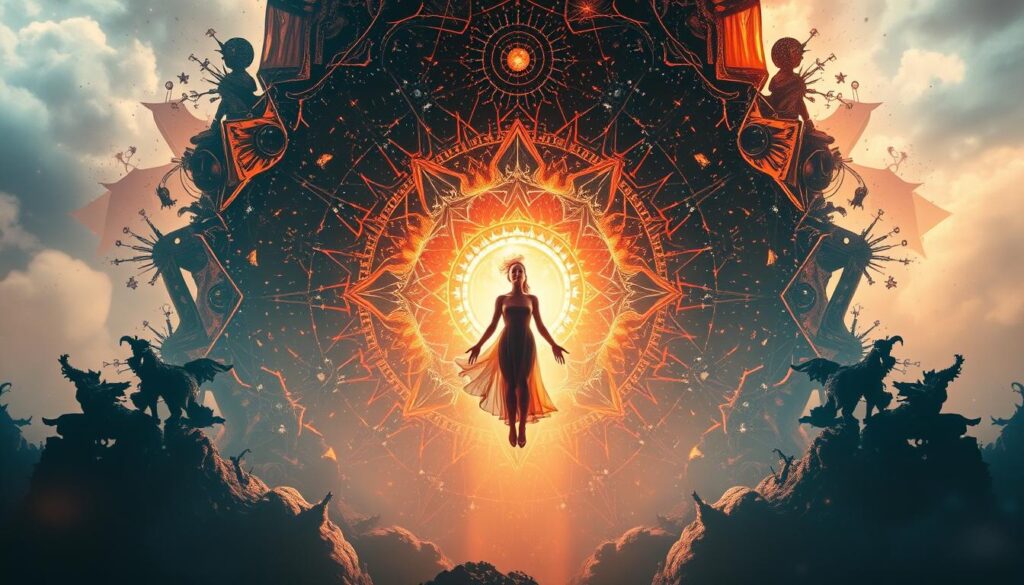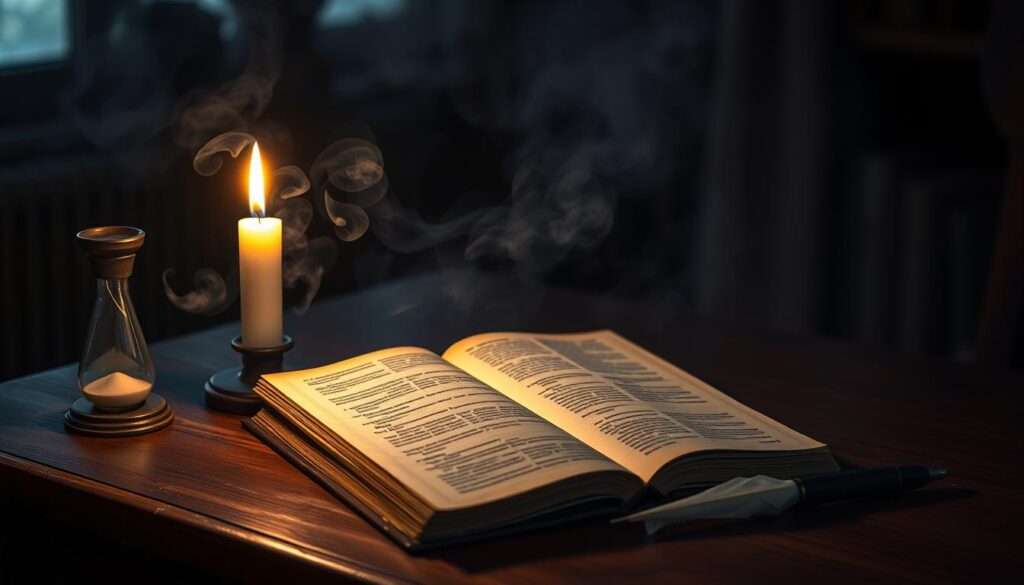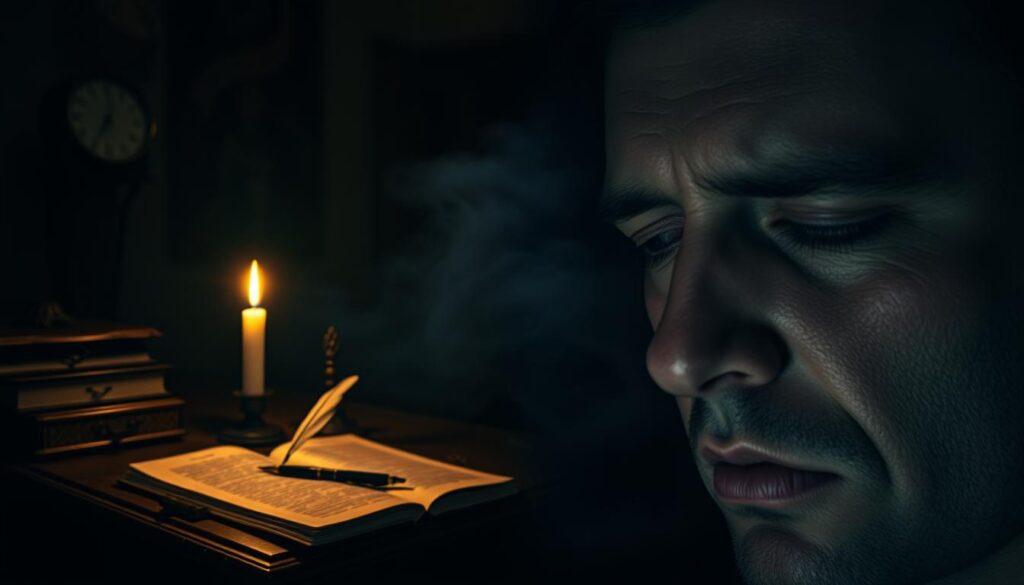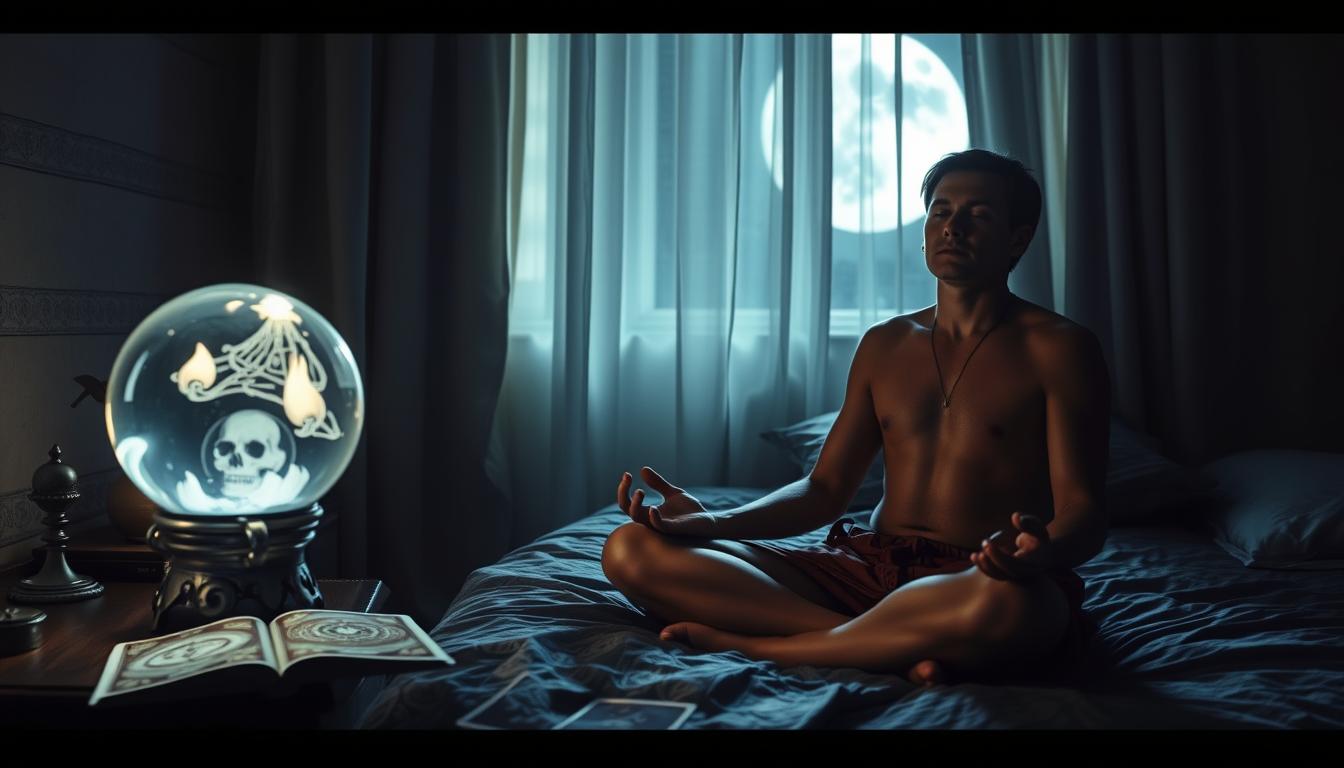Have you ever woken up from a vivid dream that later came true? You’re not alone. Studies show that 40% of adults recall at least one experience where their subconscious seemed to glimpse the future. These moments can feel surreal, leaving many wondering if there’s more to sleep than meets the eye.
Famous cases, like Bonnie Page dreaming of Bing Crosby’s letter before it arrived, spark curiosity. Even Carl Jung explored how meaningful coincidences connect to our inner world. Modern science now studies how the brain processes these mysterious events.
In this article, we’ll uncover six key signs that your nighttime visions might hold deeper meaning. Whether it’s déjà vu or emotional clarity, understanding these signals could change how you view your life’s journey.
Key Takeaways
- 40% of people report having at least one prophetic dream.
- Historical and modern cases suggest dreams may reveal future events.
- Neuroscience is uncovering how the brain processes these experiences.
- Emotional intensity often marks significant dreams.
- Recognizing patterns can help distinguish ordinary dreams from meaningful ones.
What Are Psychic Dreams? Understanding Precognitive Visions
The mind sometimes glimpses moments before they happen—without explanation. These precognitive dreams defy logic, offering flashes of future events or encounters. Unlike typical dreaming, which processes daily memories, these visions feel eerily specific.

Defining Clairvoyant and Precognitive Dreams
Precognitive dreams reveal future scenes directly, like Bonnie Page foreseeing Bing Crosby’s letter. Clairvoyant ones use symbols—a crumbling bridge might warn of a coming conflict. Both tap into extrasensory material, bypassing normal senses.
“The collective unconscious holds archetypes that transcend individual experience.”
How Psychic Dreams Differ from Regular Dreams
Ordinary dreams recycle daily stress or random thoughts. Psychic ones stand out:
- Emotional intensity: Fear or joy lingers for hours after waking.
- Sensory vividness: Smells, sounds, and textures feel hyper-real.
- Unfamiliar settings: Places or people you’ve never met appear.
Freud saw dreams as repressed desires. Jung argued they could be portals to shared human wisdom. Science still debates—but the mystery remains.
6 Key Signs Your Dreams Might Be Predicting the Future
Certain nighttime experiences defy logic, hinting at events yet to come. While most dreams fade by morning, others leave an uncanny imprint—like a roadmap to the predict future. Here’s how to spot the difference.

Vivid, Emotionally Charged Imagery
Predictive visions often burst with hyper-realistic details. Think swirling colors, sharp smells, or textures you can almost touch. A patient once dreamed of a school shooting two days before it happened—the gunfire’s echo felt deafening.
Dreams That Later Unfold in Reality
Like Eryl Mai Jones’ Aberfan disaster premonition, some scenes replay in real life. Others manifest subtly, like dreaming of a flat tire—then getting one the next day.
Symbolic Patterns with Real-Life Parallels
A tsunami in sleep might signal emotional overwhelm. Kennedy’s assassination appeared in strangers’ dreams as falling stars or broken statues. Symbols act as metaphors for coming experiences.
| Ordinary Dreams | Predictive Dreams |
|---|---|
| Fuzzy, disjointed scenes | Crystal-clear sequences |
| Fades quickly | Lingers for hours/days |
| Daily life themes | Unfamiliar settings/people |
Premonitions About Unfamiliar People or Places
Ever met someone in a dream before seeing them in real life? These “stranger premonitions” often mark significant future connections.
Recurring Themes with Prophetic Undertones
Repeated visions—like drowning or flying—may be your subconscious emphasizing a message. Note the details; they often hold clues.
Strong Intuitive Feelings Upon Waking
A physical “knowing”—goosebumps, a racing heart—can signal a meaningful vision. Trust that gut reaction; it’s rarely wrong.
The Science Behind Psychic Dreams Predictions
Science is now unraveling why some nighttime visions mirror future events. From brain scans to quantum physics, researchers explore how the mind might process information beyond linear time. Here’s what they’ve discovered.

Neuroscience and Dream Research
fMRI studies show identical brain activity during vivid dreams and real-life perception. The hippocampus (linked to memory) and amygdala (emotion center) light up intensely in precognitive dreams. A Japanese study even found dreamers could replicate object recognition patterns while asleep.
PTSD patients often report heightened prophetic visions. Trauma may sharpen the brain’s ability to detect subtle future signals—like an overactive alarm system.
The Role of the Subconscious Mind
Your subconscious processes 11 million bits of data per second; your conscious mind handles just 50. This gap explains why insights surface in sleep, where the brain filters fewer inputs. Recurring themes? They’re likely your mind emphasizing unresolved patterns.
- REM cycles: These deep sleep phases consolidate memories—and may stitch together future glimpses.
- Symbolic coding: The subconscious speaks in metaphors (e.g., storms = turmoil).
Quantum Theories on Time and Perception
Rupert Sheldrake’s morphic fields suggest collective memory could transcend individual experience. Quantum entanglement hints that particles communicate instantly across time—raising questions: Could the brain tap into this web?
“Time may be a construct our brains impose. At quantum levels, past and future could coexist.”
While science hasn’t proven prophetic dreams, it’s clear our minds process reality in ways we’re just beginning to understand.
Spiritual and Metaphysical Perspectives
Across cultures and centuries, humans have sought meaning in visions that transcend time. These experiences often align with spiritual beliefs—from ancestral messages to theories about collective consciousness.

Jung’s Collective Unconscious Theory
Carl Jung proposed that all people share a hidden layer of mind called the collective unconscious. Common symbols like water (emotions) or falling (loss) appear in precognitive dreams worldwide.
His research showed these archetypes often predict life changes. For example, tsunami dreams frequently precede emotional upheavals.
Messages from Spirit Guides or Ancestors
Many traditions believe departed loved ones communicate through dreams. Bonnie Page documented spirit teams delivering warnings via vivid imagery.
- Recognition signs: Familiar scents or gestures from deceased relatives
- Symbolic guidance: Animals or objects representing ancestral wisdom
Morphic Fields and Energetic Connections
Biologist Rupert Sheldrake’s morphic resonance theory explains how twins often share identical dreams. Energy fields may allow minds to connect across distances.
“Shared experiences suggest consciousness isn’t confined to individual brains.”
In the 1960s, Dr. John Middleton called premonitions bureau tracked hundreds of predictive cases—including the Aberfan disaster warnings.
From Greek oracles to modern mediums, the view of dreams as prophetic channels persists. Whether spiritual or scientific, these perspectives remind us: some mysteries defy easy explanation.
How to Interpret Your Psychic Dreams
Your subconscious speaks in symbols—learning its language reveals hidden insights. With the right approach, those mysterious midnight stories can become a compass for navigating waking life.

Capture the Details Immediately
Morning fog blurs dream recall, so keep a notebook by your bed. Voice memo apps like DreamKeeper help when you’re too sleepy to write. Bonnie Page swore by recording three key elements:
- Dominant colors: Red often signals urgency
- Unusual sensations: Floating might mean upcoming changes
- Strange objects: Keys frequently represent new opportunities
Crack the Symbolic Code
That tsunami vision? For marketing exec Rachel, it foreshadowed a career pivot—not disaster. Water symbolizes emotion in most traditions. Create your personal glossary by noting:
- Recurring characters (teachers often mirror mentors)
- Architecture (broken stairs may warn of obstacles)
- Weather patterns (storms usually mean turmoil)
“Symbols are the mind’s shorthand. A single image can contain volumes of meaning.”
Connect the Dots Carefully
When Sarah dreamed of a car crash, she avoided highways for a week—only to witness a fender bender at the grocery store. Use this validation checklist:
- Did the real life event match core elements (location, emotions)?
- Was the timing within two lunar cycles?
- Did others experience the event too?
Beware confirmation bias. Not every black cat means bad luck—sometimes it’s just a memory of your neighbor’s pet. Track correlations over months to make sense of true patterns.
Famous Cases of Precognitive Dreams
History holds chilling accounts of visions that foretold real-life tragedies. These documented cases provide some of the strongest evidence that certain experiences transcend normal perception. From government archives to personal journals, the patterns are too striking to ignore.

The Aberfan Disaster Premonition
In October 1966, a coal waste landslide buried a Welsh school, killing 144 people. What makes this tragedy extraordinary are the 60+ premonitions recorded beforehand. One notable example came from Eryl Mai Jones, a 10-year-old victim who told her mother: “I’m not afraid to die—I’ll be with Peter and June.”
Dr. John Barker’s called premonitions bureau later collected dozens of similar accounts. People reported visions of black mountains, children screaming, and school clocks stopping at 9:15 AM—the exact time of the disaster. Neurologists note such events often trigger heightened subconscious awareness in sensitive individuals.
Robert Kennedy’s Assassination Dreams
Two days before Senator Kennedy was shot on June 5, 1968, multiple people contacted authorities with warnings. One woman dreamed of “a man in a crowded kitchen with a shiny object.” Another saw newspaper headlines about a “Kennedy tragedy.”
The called premonitions bureau documented these accounts through psychiatrist J.C. Barker. His research showed that 18% of predictive visions involve public figures. Modern analysts suggest such dreams may tap into collective anxiety patterns.
Modern-Day Accounts and Studies
Contemporary research continues to explore these phenomena. The Windbridge Institute analyzed 9/11-related visions, finding 187 credible accounts recorded beforehand. Their 2017 study revealed common themes:
- Falling bodies (32% of cases)
- Twin symbols (28%)
- Smoke inhalation sensations (19%)
Ethical questions remain about acting on such information. While some advocate for dream registries, others warn against causing unnecessary panic. As science advances, these historical cases remind us that human perception may hold untapped potential.
Enhancing Your Connection to Psychic Dreams
Your nighttime visions can become clearer with simple daily habits. Like tuning a radio, small adjustments help receive signals with less static. These methods combine ancient wisdom with neuroscience-backed techniques.

Practices to Improve Dream Recall
Start with galantamine or Calea Z—herbs known to boost vividness. Keep a journal within arm’s reach; morning fragments fade within minutes. Try these retention tricks:
- Mnemonic anchors: Repeat “I’ll remember” while falling asleep
- Binaural beats: 4Hz theta waves prime the brain for recall
- Hydration: Dehydration reduces REM cycles by 30%
Meditation and Setting Intentions
Bonnie Page’s ritual involved 10 minutes of breathwork before bed. This clears mental clutter, making space for meaningful experiences. Visualize a silver thread connecting you to your future self as you drift off.
“Intentions act like GPS coordinates for the subconscious mind.”
Creating a Sleep Environment for Clarity
Feng shui principles suggest positioning your bed to face east—the direction of new beginnings. Eliminate these common disruptors:
- Blue light (use amber bulbs after sunset)
- Electronics within 3 feet of your pillow
- Alcohol within 4 hours of bedtime
For serious seekers, try a “dream incubation” script. Write a question before sleep, then place it under your pillow. Many report answers appearing within three nights.
Remember: consistency matters more than perfection. Even small changes, like going to bed at the same time nightly, can sharpen your ability to predict future patterns. Your mind already knows the way—you’re just learning its language.
Conclusion: Embracing the Mystery of Psychic Dreams
The line between intuition and reality often blurs in sleep. Whether through vivid symbols or déjà vu moments, these experiences invite us to broaden our view of consciousness. Duke University’s ongoing studies suggest the brain may process glimpses of the future differently than memories.
Societal stigma around these phenomena is fading, thanks to open dialogues about mental health and neuroscience. Tools like dream journals or apps (try DreamKeeper) can help you explore safely. As Carl Jung noted, “The privilege of a lifetime is to become who you truly are.”
Stay curious. What starts as a strange midnight vision might enrich your daily life in unexpected ways. The mystery remains—but that’s part of the wonder.

